Choosing a Gaming CPU at 1440p: Adding in Haswell
by Ian Cutress on June 4, 2013 10:00 AM ESTFor an article like this getting a range of CPUs, which includes the most common and popular, is very important. I have been at AnandTech for just over two years now, and in that time we have had Sandy Bridge, Llano, Bulldozer, Sandy Bridge-E, Ivy Bridge, Trinity and Vishera, of which I tend to get supplied the top end processors of each generation for testing (as a motherboard reviewer, it is important to make the motherboard the limiting factor). A lot of users have jumped to one of these platforms, although a large number are still on Wolfdale (Core2), Nehalem, Westmere, Phenom II (Thuban/Zosma/Deneb) or Athlon II. I have attempted to pool all my AnandTech resources, contacts, and personal resources, together to get a good spread of the current ecosystem, with more focus on the modern end of the spectrum. It is worth nothing that a multi-GPU user is more likely to have the top line Ivy Bridge, Vishera or Sandy Bridge-E CPU, as well as a top range motherboard, rather than an old Wolfdale. Nevertheless, we will see how they perform. There are a few obvious CPU omissions that I could not obtain for this first review which will hopefully be remedied over time in our next update.
The CPUs
My criteria for obtaining CPUs was to use at least one from the most recent architectures, as well as a range of cores/modules/threads/speeds. The basic list as it stands is:
AMD |
|||||||
| Name |
Platform / Architecture |
Socket |
Cores / Modules (Threads) |
Speed | Turbo | L2/L3 Cache | |
|---|---|---|---|---|---|---|---|
| A6-3650 | Llano | FM1 | 4 (4) | 2600 | N/A | 4 MB / None | |
| A8-3850 | Llano | FM1 | 4 (4) | 2900 | N/A | 4 MB / None | |
| A8-5600K | Trinity | FM2 | 2 (4) | 3600 | 3900 | 4 MB / None | |
| A10-5800K | Trinity | FM2 | 2 (4) | 3800 | 4200 | 4 MB / None | |
| Phenom II X2-555 BE | Callisto K10 | AM3 | 2 (2) | 3200 | N/A | 1 MB / 6 MB | |
| Phenom II X4-960T | Zosma K10 | AM3 | 4 (4) | 3200 | N/A | 2 MB / 6 MB | |
| Phenom II X6-1100T | Thuban K10 | AM3 | 6 (6) | 3300 | 3700 | 3 MB / 6 MB | |
| FX-8150 | Bulldozer | AM3+ | 4 (8) | 3600 | 4200 | 8 MB / 8 MB | |
| FX-8350 | Piledriver | AM3+ | 4 (8) | 4000 | 4200 | 8 MB / 8 MB | |
Intel |
|||||||
| Name | Architecture | Socket |
Cores / Modules (Threads) |
Speed | Turbo | L2/L3 Cache | |
| E6400 | Conroe | 775 | 2 (2) | 2133 | N/A | 2 MB / None | |
| E6550 | Conroe | 775 | 2 (2) | 2333 | N/A | 4 MB / None | |
| E6700 | Conroe | 775 | 2 (2) | 2667 | N/A | 4 MB / None | |
| Q9400 | Yorkfield | 775 | 4 (4) | 2667 | N/A | 6 MB / None | |
| Xeon X5690 | Westmere | 1366 | 6 (12) | 3467 | 3733 | 1.5 MB / 12 MB | |
| Celeron G465 | Sandy Bridge | 1155 | 1 (2) | 1900 | N/A | 0.25 MB / 1.5 MB | |
| Core i5-2500K | Sandy Bridge | 1155 | 4 (4) | 3300 | 3700 | 1 MB / 6 MB | |
| Core i7-2600K | Sandy Bridge | 1155 | 4 (8) | 3400 | 3800 | 1 MB / 8 MB | |
| Core i7-3930K | Sandy Bridge-E | 2011 | 6 (12) | 3200 | 3800 | 1.5 MB / 12 MB | |
| Core i7-3960X | Sandy Bridge-E | 2011 | 6 (12) | 3300 | 3900 | 1.5 MB / 15 MB | |
| Core i3-3225 | Ivy Bridge | 1155 | 2 (4) | 3300 | N/A | 0.5 MB / 3 MB | |
| Core i7-3770K | Ivy Bridge | 1155 | 4 (8) | 3500 | 3900 | 1 MB / 8 MB | |
| Core i7-4770K | Haswell | 1150 | 4 (8) | 3500 | 3900 | 1 MB / 8 MB | |
There omissions are clear to see, such as the i7-3570K, a dual core Llano/Trinity, a dual/tri module Bulldozer/Piledriver, i7-920, i7-3820, or anything Nehalem. These will hopefully be coming up in another review.
The GPUs
My first and foremost thanks go to both ASUS and ECS for supplying me with these GPUs for my test beds. They have been in and out of 60+ motherboards without any issue, and will hopefully continue. My usual scenario for updating GPUs is to flip AMD/NVIDIA every couple of generations – last time it was HD5850 to HD7970, and as such in the future we will move to a 7-series NVIDIA card or a set of Titans (which might outlive a generation or two).
The ASUS HD 7970 we use is the reference model at the 7970 launch, using GCN architecture, 2048 SPs at 925 MHz with 3 GB of 4.6 GHz GDDR5 memory. We have four cards to be used in 1x, 2x, 3x and 4x configurations where possible, also using PCIe 3.0 when enabled by default.
ECS GTX 580 (NGTX580-1536PI-F)
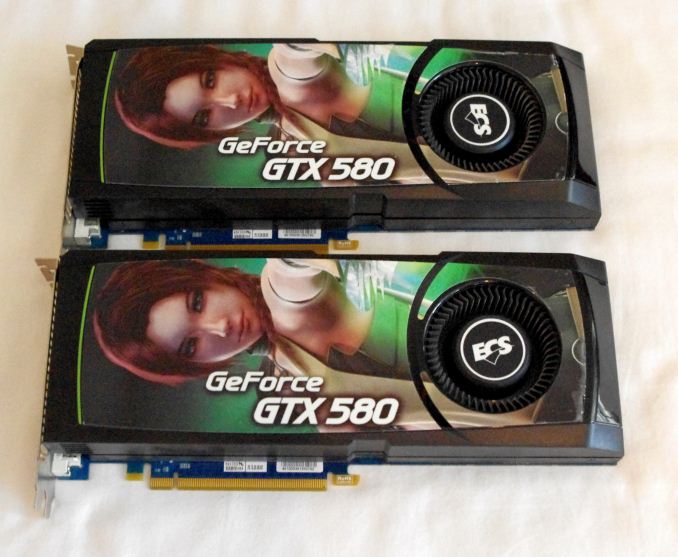
ECS is both a motherboard manufacturer and an NVIDIA card manufacturer, and while most of their VGA models are sold outside of the US, some do make it onto e-e-tailers like Newegg. This GTX 580 is also a reference model, with 512 CUDA cores at 772 MHz and 1.5 GB of 4 GHz GDDR5 memory. We have two cards to be used in 1x and 2x configurations at PCIe 2.0.
The Motherboards
The CPU is not always the main part of the picture for this sort of review – the motherboard is equally important as the motherboard dictates how the CPU and the GPU communicates with each other, and what the lane allocation will be. As mentioned on the previous page, there are 20+ PCIe configurations for Z77 alone when you consider some boards are native, some use a PLX 8747 chip, others use two PLX 8747 chips, and about half of the Z77 motherboards on the market enable four PCIe 2.0 lanes from the chipset for CrossFireX use (at high latency). We have tried to be fair and take motherboards that may have a small premium but are equipped to deal with the job. As a result, some motherboards may also use MultiCore Turbo, which as we have detailed in the past, gives the top turbo speed of the CPU regardless of the loading.
As a result of this lane allocation business, each value in our review will be attributed to both a CPU, whether it uses MCT, and a lane allocation. This would mean something such as i7-3770K+ (3 - x16/x8/x8) would represent an i7-3770K with MCT in a PCIe 3.0 tri-GPU configuration. More on this below.
For Haswell: Gigabyte Z87X-UD3H, ASUS Z87-Pro, and MSI Z87-GD65 Gaming
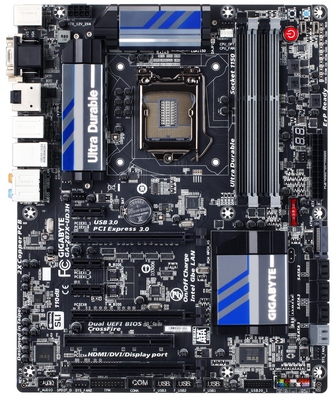
The ASUS Z87-Pro nominally offers an PCIe 3.0 x8/x8 layout with an additional PCIe 2.0 x4 from the PCH, however this starts in x1 mode without a change in the BIOS.
The MSI Z87A-GD65 gives us PCI 3.0 x8/x4/x4.
The Gigabyte Z87X-UD3H gives PCIe 3.0 x8/x8 + PCIe 2.0 x4, but this motherboard was tested with MCT off.
For Sandy Bridge and Ivy Bridge: ASUS Maximus V Formula, Gigabyte Z77X-UP7 and Gigabyte G1.Sniper M3

The ASUS Maximus V Formula has a three way lane allocation of x8/x4/x4 for Ivy Bridge, x8/x8 for Sandy Bridge, and enables MCT.
The Gigabyte Z77X-UP7 has a four way lane allocation of x16/x16, x16/x8/x8 and x8/x8/x8/x8, all via a PLX 8747 chip. It also has a single x16 that bypasses the PLX chip and is thus native, and all configurations enable MCT.
The Gigabyte G1.Sniper M3 is a little different, offering x16, x8/x8, or if you accidentally put the cards in the wrong slots, x16 + x4 from the chipset. This additional configuration is seen on a number of cheaper Z77 ATX motherboards, as well as a few mATX models. The G1.Sniper M3 also implements MCT as standard.
For Sandy Bridge-E: ASRock X79 Professional and ASUS Maximus IV Extreme
The ASRock X79 Professional is a PCIe 2.0 enabled board offering x16/x16, x16/x16/x8 and x16/x8/x8/x8.
The ASUS Maximus IV Extreme is a PCIe 3.0 enabled board offering the same as the ASRock, except it enables MCT by default.
For Westmere Xeons: The EVGA SR-2
Due to the timing of the first roundup, I was able to use an EVGA SR-2 with a pair of Xeons on loan from Gigabyte for our server testing. The SR-2 forms the basis of our beast machine below, and uses two Westmere-EP Xeons to give PCIe 2.0 x16/x16/x16/x16 via NF200 chips.
For Core 2 Duo: The MSI i975X Platinum PowerUp and ASUS Commando (P965)
The MSI is the motherboard I used for our quick Core2Duo comparison pipeline post in Q1 2013 – I still have it sitting on my desk, and it seemed apt to include it in this test. The MSI i975X Platinum PowerUp offers two PCIe 1.1 slots, capable of Crossfire up to x8/x8. I also rummaged through my pile of old motherboards and found the ASUS Commando with a CPU installed, and as it offered x16+x4, this was tested also.
For Llano: The Gigabyte A75-UD4H and ASRock A75 Extreme6
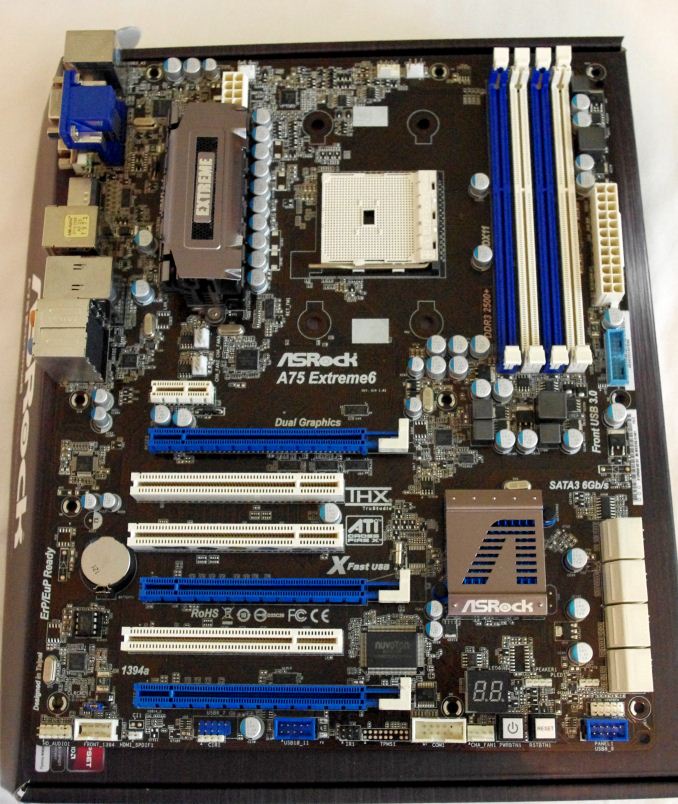
Llano throws a little oddball into the mix, being a true quad core unlike Trinity. The A75-UD4H from Gigabyte was the first one to hand, and offers two PCIe slots at x8/x8. Like the Core2Duo setup, we are not SLI enabled.
After finding an A8-3850 CPU as another point against the A6-3650, I pulled out the A75 Extreme6, which offers three-way CFX as x8/x8 + x4 from the chipset as well as the configurations offered by the A75-UD4H.
For Trinity: The Gigabyte F2A85X-UP4
Technically A85X motherboards for Trinity support up to x8/x8 in Crossfire, but the F2A85X-UP4, like other high end A85X motherboards, implements four lanes from the chipset for 3-way AMD linking. Our initial showing on three-way via that chipset linking was not that great, and this review will help quantify this.
For AM3: The ASUS Crosshair V Formula
As the 990FX covers a lot of processor families, the safest place to sit would be on one of the top motherboards available. Technically the Formula-Z is newer and supports Vishera easier, but we have not had the Formula-Z in to test, and the basic Formula was still able to run an FX-8350 as long as we kept the VRMs cool as a cucumber. The CVF offers up to three-way CFX and SLI testing (x16/x8/x8).
The Memory
Our good friends at G.Skill are putting their best foot forward in supplying us with high end kits to test. The issue with the memory is more dependent on what the motherboard will support – in order to keep testing consistent, no overclocks were performed. This meant that boards and BIOSes limited to a certain DRAM multiplier were set at the maximum multiplier possible. In order to keep things fairer overall, the modules were adjusted for tighter timings. All of this is noted in our final setup lists.
Our main memory testing kit is our trusty G.Skill 4x4 GB DDR3-2400 9-11-11 1.65 V RipjawsX kit which has been part of our motherboard testing for over twelve months. For times when we had two systems being tested side by side, a G.Skill 4x4 GB DDR3-2400 10-12-12 1.65 V TridentX kit was also used.
For The Beast, which is one of the systems that has the issue with higher memory dividers, we pulled in a pair of tri-channel kits from X58 testing. These are high-end kits as well, currently discontinued as they tended to stop working with too much voltage. We have a sets of 3x2 GB OCZ Blade DDR3-2133 8-9-8 and 3x1 GB Dominator GT DDR3-2000 7-8-7 for this purpose, which we ran at 1333 6-7-6 due to motherboard limitations at stock settings.
Our Core2Duo CPUs clearly gets their own DDR2 memory for completeness. This is a 2x2 GB kit of OCZ Platinum DDR2-666 5-5-5.
For Haswell we were offered new kits for testing, this time from Corsair and their Vengeance Pro series. This is a 2x8 GB kit of DDR3-2400 10-12-12 1.65 V.


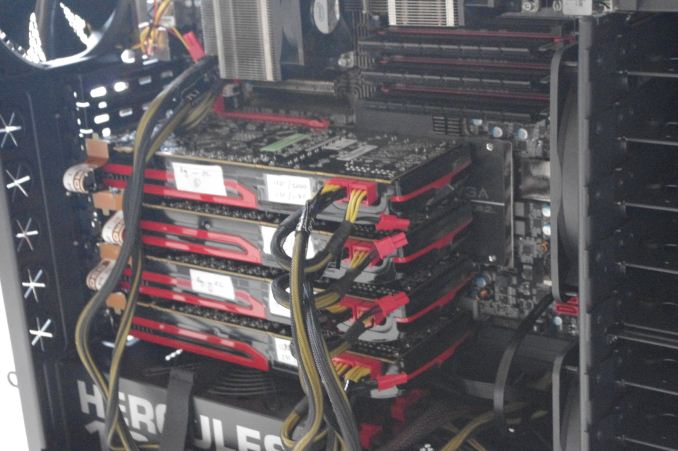
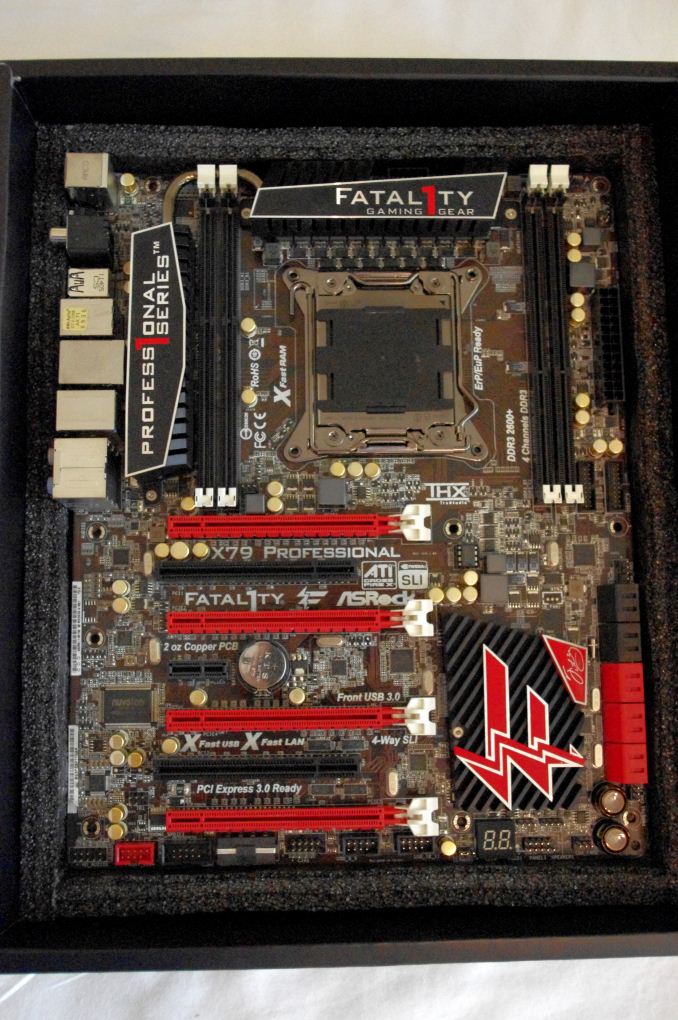
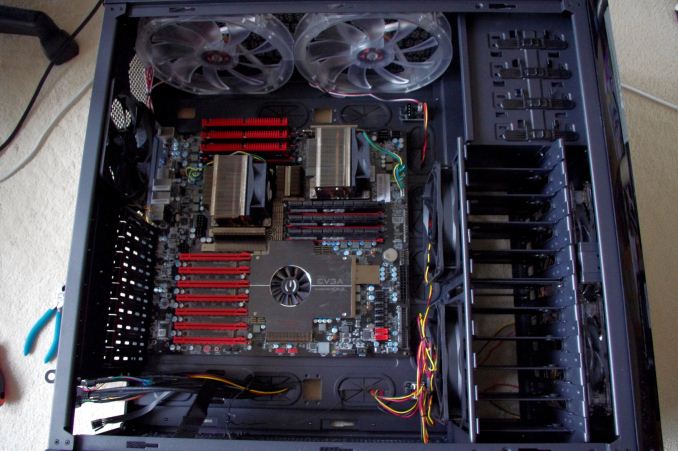
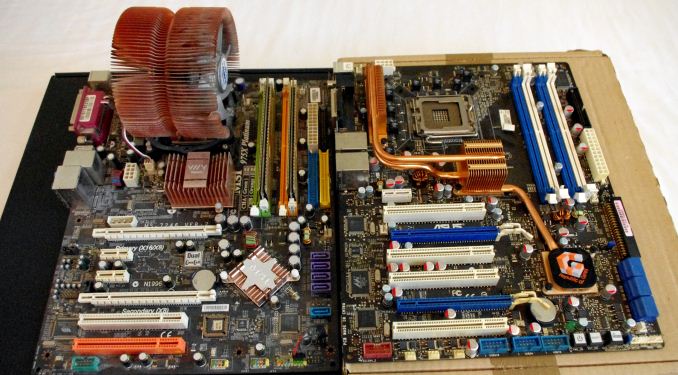
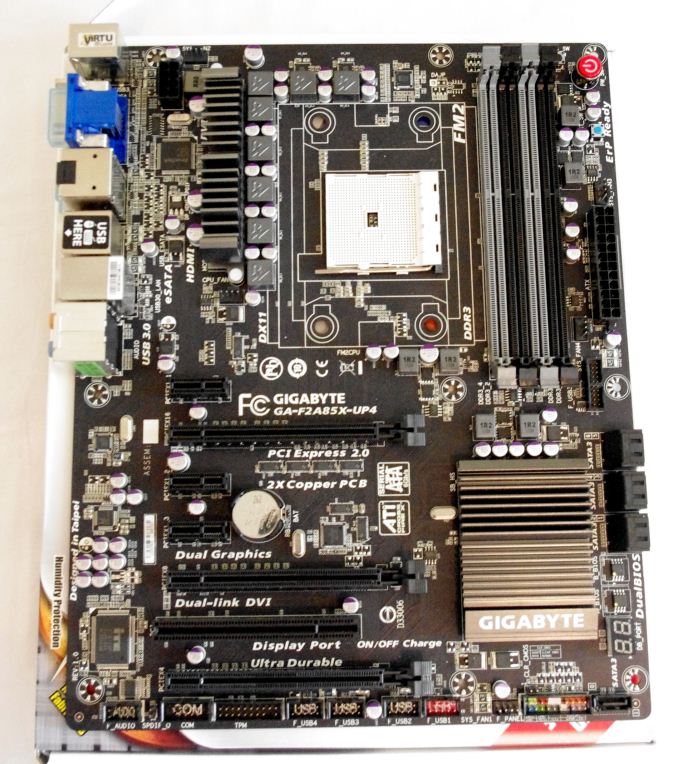
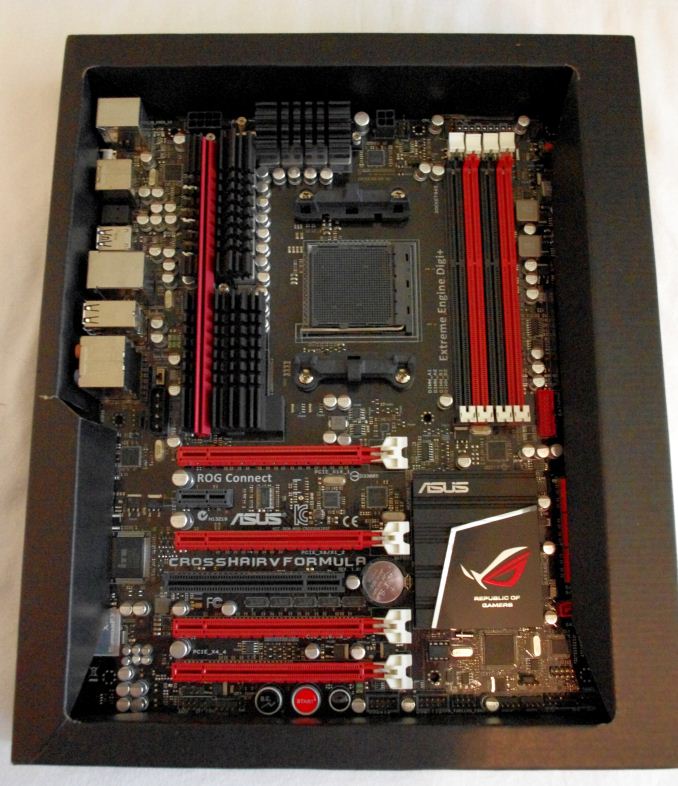

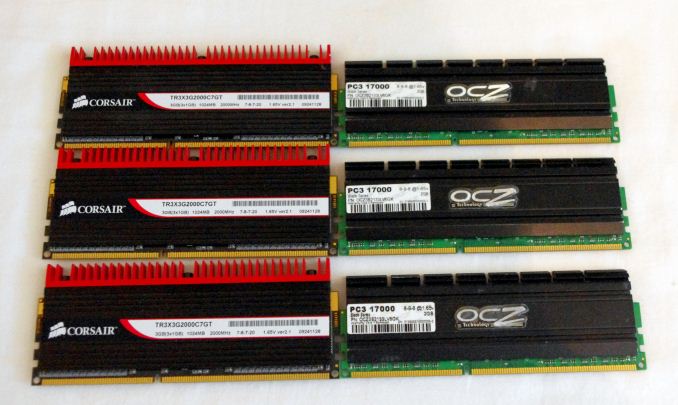
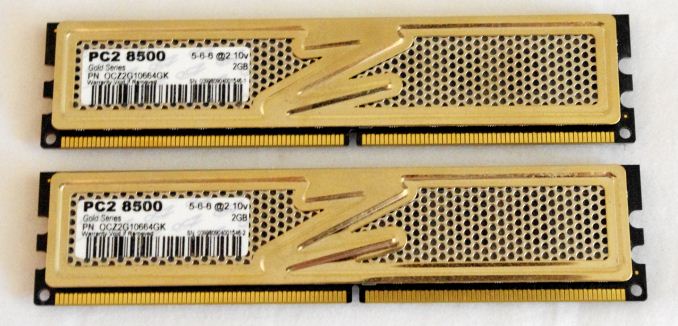
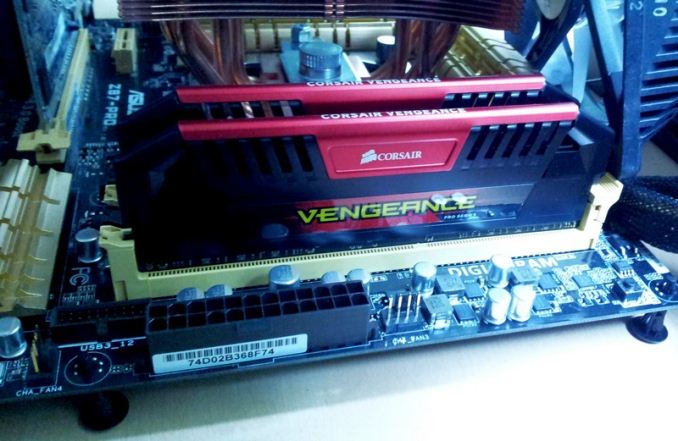








116 Comments
View All Comments
Dentons - Tuesday, June 4, 2013 - link
He's complaint is on the mark. Haswell is about mobile, not desktop, not gaming.Ivy Bridge was about cost reduction, Haswell is about reducing TDP. It is shocking that a mid-range 2+ year old Sandy Bridge desktop part is still so very competitive, even though it's been superseded by two whole generations.
Intel deserves all this criticism and more. They've clearly put the interests of desktop users and gamers far onto the back burner. They're now focused on almost entirely mobile and are treading water with everything else.
takeship - Tuesday, June 4, 2013 - link
Eh, how can you blame them? The pure play desktop market has been shrinking for a while now, with high performance desktop (basically gamers) even more of a niche. Maybe if they had some real competition from AMD in single threaded perf... A lot of this is just Amdahl's law at it's natural conclusion. The easy performance gains are mostly gone, so if you're Intel do you dump endless money into another 25-30% per generation, or go after the areas that haven't been well optimized yet instead? Not a hard choice to make, especially considering the market moves towards mobile & cool computing in the last decade.Silma - Wednesday, June 5, 2013 - link
Intel doesn't deserve criticism. Haswell is a small improvement over Ivy Bridge because it has become extremely difficult to optimize and already excellent processor. Do you see anything better from AMD, ARM, Oracle or others?Is there a need to upgrade from Ivy to Haswell? No. Was it necessary to upgrade from Nethalem to Sandy Bride? No. The fact is that for most applications processors have been good enough for years and money is better spent on ssds, gpus and whatnot.
The real conclusion of this article should be that processors absolutely do not matter for gaming and that the money is better spent on speedier gpu. Processors may become relevant for the very very very few people that have extreme 2/3x extreme cards. Even a setup with 2 middle cards such as gtx 560 is not cpu dependent. I would welcome actual statistics from the number of players with 2x 3x high-end gpus. I'm quite sure the count is ultra tiny and for those people willing and able to spend thousand of dollars, do you think 100$ less on a processor is relevant?
chizow - Wednesday, June 5, 2013 - link
I don't have a problem with the conclusion he comes to, complaining about dissemination of information to come to that conclusion is what makes no sense. Put all the information out there, 1, 2, 3 articles a day np, then make your own informed decision on the platform. Bemoan the fact there is actual coverage a day or two after launch and one or two reviews? Makes no sense.Memristor - Tuesday, June 4, 2013 - link
Too bad that Richland, which is available as of today, didn't make it into this review. Other than that great read.eddieobscurant - Tuesday, June 4, 2013 - link
many of us have a q6600 @ 3600mhz, and personally i'm very happy this and my 7870. I would still like to see a comparison of my cpu @ 3600mhz, with the modern cpus because i don't think there is a huge difference in games.chizow - Tuesday, June 4, 2013 - link
It depends what you play, any game that is CPU limited is going to be HUGE difference with that CPU. I had the same chip at 3.6GHz, which was great btw, and even when I upgraded to 920 @4GHz there was huge improvement in some games, most notably GTA4 at the time. Some other games that scale extremely well with CPU are WoW, Diablo 3, etc. just to name a few.medi02 - Wednesday, June 5, 2013 - link
Nah. Most of the tests show that to get CPU limited you need a multi-GPU setup.i7 and intel mobo will cost you about 500$ with marginal improvements.
chizow - Wednesday, June 5, 2013 - link
Sorry, just not true. Even with just 1x680 WoW and other similarly CPU dependent games scale tremendously well with faster CPUs:http://www.tomshardware.com/reviews/fx-8350-visher...
Q6600 @ 3.6 is probably just a tad faster than the Phenom IIs in that test.
TheJian - Thursday, June 6, 2013 - link
See my comments here...Chizow is correct, and even understating it some. There are a LOT of games cpu limited as I showed in my links. Huge differences in cpu perf from A10-5800 up to 4770k, never mind the junk Ian recommends here A8-5600 for single gpu. It just isn't correct to recommend that cpu or even A10-5800K which I showed getting smacked around in many games at 1080p. Articles like this make people think games are not cpu bound (it's far more games than Civ5). Neverwinter, Metro Last light, tomb raider, Farcry3, Crysis 3 etc etc...Once 20nm comes we may find even 1440p showing just as many limited by cpu. If rumors are true Volcanic doubles stream processors. I'm sure NV will match that. You end up gpu bound when you up the res to 1440 on single cards now, but that won't be forever and 98.75% of us according to steam don't play at 1440p (.87%) or above (1.25% total of all res above 1920x1200).Check the 1080p data on my links (techreport was a good one as they show 1080p in most of the listed games). Toms shows neverwinter as I noted needing a very high cpu also. Hit all comments on this article, and Ctrl-F my name. Ignore my post comments and just click the links in them to prove Chizow's point (and my own). CPU is important at 1080p and 1920x1200 NOW and will be important at higher res with the next gen cards at 20nm. You will never get out of your AMD mistake if you take this article's suggestions. Well at least not without changing to an Intel board/chip...LOL. Who wants to do that? Just buy an Intel unless you're broke. Don't trust me though, read the links provided and judge for yourself how accurate anandtech is here.
I showed some games that are nearly DOUBLE on Intel vs. A10-5800K! You don't have to like the way I made my point or believe me, just check the links :) They all say the same thing. CPU is an issue just as Chizow shows in his link. You can find this in many cpu articles where they use a top gpu (usually 7970/680) and test new cpus with the oldies in there too which show large separations. Check i7-3770k or fx 8350 articles (just google those two cpu models and "review" for ample sites showing the spreak)...1080p separates the men from the boys in cpu's.
After you check the links (and chizow's), come back and agree Anandtech needs to change their ways, or tear my comments apart if I'm lying :) Future gpu's will only make our point stick out even more. CPU matters. Also note a lot of the games that are gpu limited on single cards are NOT playable anyway (check sleeping dogs right here in this article 1440p...7970 at 28fps avg is NOT playable, mins will dip to 20's or below). So you're forced back into cpu limited in a lot of cases at 1080p. Where 98.75% of us play you see cpu limits a lot.
Go back one page on Chizow's link to Skyrim's benchmark in the same article for the same data. 1080p 3770 scores 88.2 to 8350's 67.4 (that's a lot and a huge hint to how your future on AMD will look)
http://www.tomshardware.com/reviews/fx-8350-visher...
That's a 30% difference and an 8350FX is far faster than an A8-5600 Ian recommends here. Chizow is even more right if you toss in Ian's recommendation of an even slower cpu than 8350 vs. Intel's stuff. Even in skyrim at 1680x1050 they separate from 90fps to 68fps for 8350fx. So until you completely tap out your gpu (1440p and up which basically requires 2+ cards) you will notice if your cpu is junk or not. Since this article is only written for apparently 1.25% of the readership (or world for that matter according to steam survey), you will notice the cpu! Unless you're raising your hand as the 1.25% :) I don't call 30-100% faster marginal improvements do you? Add CIV 5 also which this site even proves in this article ;) At least they got something right.